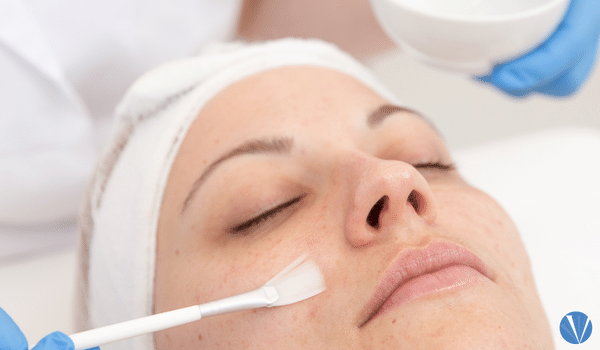Whether you’re thinking about getting a chemical peel or are about to receive your first peel and wondering what the aftercare entails, this guide is for you. Chemical peel aftercare is an important step in the process. Chemical peels are one of the most common cosmetic dermatology treatments in the US used to improve skin texture and complexion. Proper aftercare is important for preventing breakouts, infection, and scarring. Before we dive into this chemical peel aftercare guide, let’s find out more about what to expect during a chemical peel treatment.
During a chemical peel, a chemical solution, which exfoliates the skin and eventually causes it to peel, is applied. This typically results in smoother skin with better tone and color. However, not everyone is the perfect candidate for a chemical peel. Your dermatologist can help you decide if a chemical peel is the right cosmetic treatment e for you.
What Are the Benefits of a Chemical Peel?
If you’re reading this blog, you may or may not already know some of the chemical peel benefits. Most benefits can be lumped into one phrase – improved skin – but what does that actually mean? It means chemical peels can help minimize pores and fine lines and wrinkles, smooth skin and scars, and improve the texture of your skin.
Another major benefit of a chemical peel is that it’s non-invasive, which means there are few risks associated with it. Chemical peels are safe when completed by a trained expert, but some risks include temporary or permanent discoloration and triggering cold sores. Medication can be prescribed before the procedure to reduce the possibility of triggering a cold sore, so talk to your dermatologist about this option if this is a concern for you.
What Should I Expect During a Chemical Peel?
What to expect during a chemical peel can vary depending on the type of chemical peel being completed. There are three types of chemical peels: a superficial (or lunchtime) peel, medium peel, and deep peel. Deep peels are not performed at Vujevich Dermatology Associates.
During a superficial peel, an alpha-hydroxy-acid or other mild acid (we use Jessner’s solution) is used to penetrate only the outer layer of the skin. This solution gently exfoliates the outer layer of skin and is used to treat mild discoloration, acne, and rough skin.
Medium peels use glycolic or trichloroacetic acid, which is applied to the outer and middle layers of the skin, to remove damaged skin cells. Medium peels are used to treat fine lines and wrinkles, skin discoloration, freckles, and age spots, as well as to smooth rough skin and treat actinic keratosis.
What to Expect After a Chemical Peel
No matter the type of chemical peel you choose, there are chemical peel aftercare guidelines to follow and an expected recovery time. Following a superficial peel, you can expect your skin to be red and scaly.
Medium peels can cause your skin to become red and swollen immediately following the peel. Swelling may become worse in the first 48 hours after the chemical peel. Surprisingly, some people do not peel following a chemical peel; if this occurs, you will still see results as the skin has peeled microscopically.
How Long Does It Take to Heal from a Chemical Peel?
You may be excited to see your new skin following your treatment, but your chemical peel recovery time can be up to 14 days depending on the type of chemical peel you received. Superficial peels heal in one to seven days. Medium peels may require seven to 14 days of recovery time. Depending on the conditions being treated with the chemical peel, you may see benefits after one treatment. Most people see the best results after three to four chemical peels, each spaced a month apart.
Top Chemical Peel Aftercare Instructions
Three main things you need to remember for your chemical peel aftercare are:
- Protect your skin
- Moisturize often
- Be gentle
Protecting your skin after the treatment is important, as your skin is extra sensitive during the chemical peel recovery time. Protecting your skin involves avoiding heat and sun exposure, which means limiting strenuous workouts, applying sunscreen, and wearing protective clothing.
Should You Moisturize After a Chemical Peel?
Yes, you should moisturize after a chemical peel. Allowing the skin to dry out may be uncomfortable, especially as you are likely to experience dry skin after a chemical peel. If you had a medium or deep peel, Vaseline can be applied to the treated area for the first few days. Once your skin begins peeling, use a non-comedogenic moisturizer until your skin is healed.
Keeping your skin moisturized during recovery promotes healing because it locks in moisture and helps reduce irritation, redness, and the chance of a bacterial infection.
How to Wash Your Face After a Chemical Peel
The main thing to remember when you’re washing your face post-chemical peel is to be gentle. Your skin is going to be extremely fragile the week following your treatment. During the healing process, use only cool water and mild cleansers to wash your face. This means using your fingertips and not washcloths, sponges, or other cleansing tools.
How to Speed Up Peeling After a Chemical Peel
Unfortunately, there is no proven way to speed up peeling following a chemical peel and some people never experience peeling. However, keeping your skin moisturized can help promote healing overall.
If you are interested in learning more about chemical peels, chemical peel aftercare, or want to schedule an appointment, you can contact our offices.
Vujevich Dermatology Associates offers medical, surgical, and cosmetic dermatology from some of the most highly trained physicians and clinicians in the greater Pittsburgh area. You can reach our team at 412-429-2570 or visit our contact page to see all of our locations. You can also follow us on Facebook to see what’s new in the world of dermatology.

